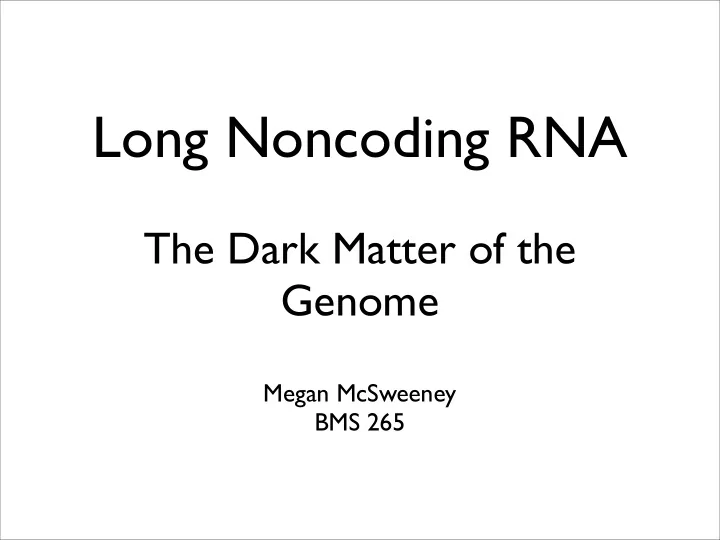

Long Noncoding RNA The Dark Matter of the Genome Megan McSweeney BMS 265
Long Noncoding RNA LncRNA is defined as all transcribed RNA molecules greater than 200 nt in length. The 200 nt cutoff is based on RNA isolation protocols. Very broad category, so lncRNAs are a very large and functionally heterogeneous group. Mouse transcriptome: ~180,000 total transcripts, ~20,000 protein coding genes. The majority of the remaining 160,000 transcripts are lncRNAs
Discovery 1980s-1990s: Individual lncRNAs are discovered through traditional gene mapping approaches, Xist and H19 . Early 2000s: Development of large scale cDNA sequencing leads to the discovery of a surprising number of lncRNA transcripts. Mid 2000s: The number of predicted genes in the mammalian genome goes down and the number of detected lncRNA transcripts increases exponentially.
Evolution and Conservation: Are lncRNAs Funtional? Transcriptional Noise • Low affinity binding of RNA polymerase to randomly generated promoter sequences. • More efficient to allow random transcripts than to downregulate nonspecific transcription. • LncRNAs are generally expressed at low levels • LncRNA sequences are not well conserved between species. LncRNAs are Functional • LncRNAs do not have the strict sequence conservation restraints that protein-coding genes do. • LncRNAs may be more plastic then protein coding genes and thus can evolve rapidly. • LncRNA promoter sequences are very well conserved.
Origins of lncRNA Sequences LncRNAs can be categorized based on their proximity to protein coding genes Mutation of a Protein Coding Gene Chromosomal Rearrangement + Duplications short ncRNA long ncRNA Transposon Insertion Legend: Green= lncRNA, Purple = Protein Coding Gene
Biogenesis: Regulation of lncRNA Expression The regulation of lncRNA expression has also been closely studied to determine if lncRNAs are functional Evidence of Function: lncRNA expression levels vary with location, time, and physiological stimuli. There are examples of all of these types of regulation. lncRNA Evf2 in developing mouse brain in situ hybridization
Biogenesis: Where are lncRNAs? Sense Antisense Bidirectional <1000 bp Intronic Intergenic Legend: Green= lncRNA, Purple = Protein Coding Gene
Mechanism of Action: Regulation of Chromatin Structure Legend: Cis Silencing Epigenetic Green= lncRNA, RNA POL Modifier Purple = Protein Coding Gene Trans Silencing RNA POL Epigenetic + Epigenetic Modifier Modifier
Mechanism of Action: Gene Regulation by lncRNA Transcription Activation via Transcription Silencing via Transcription RNA POL RNA POL Legend: Green= lncRNA, Purple = Protein Coding Gene
Mechanism of Action: Regulation of Transcription in cis Transcription Block Transcription Factor Factor Transcription Recruit Transcription Factor Factor Legend: Green= lncRNA, Purple = Protein Coding Gene
Mechanism of Action: Regulation of Transcription in trans Legend: Green= lncRNA, Transcription Factor Activation Purple = Protein Coding Gene + Transcription Transcription Factor Factor Transcription Factor Trafficking Transcription nucleus Factor Accessory Protein Activation Accessory + Accessory Accessory Protein Protein Protein
Mechanism of Action: Post Transcriptional Regulation Regulation of mRNA Transcripts Gene Silencing Pathway Legend: Legend: Green= lncRNA, Green= lncRNA, Purple = Protein Purple = Protein Coding Gene Coding Gene
Diseases • Cancer LncRNA expression profiles may be useful as biomarkers for cancer diagnosis. • Alpha-Thalassaemia An inherited form of this type of anemia is caused by the translocation of of an antisense lncRNA near the alpha-globin gene, resulting in the epigenetic silencing of the HBA2 gene and causing the disease. • Alzheimer’s Disease The beta-secretase-1 (BACE1) protein is a crucial enzyme in the progression of Alzheimer’s disease. The expression level of the antisense transcript of the BACE1 gene increases in response to cell stressors such as amyloid-beta 1-42. • Human Spinocerebellar Ataxia Type 8 Patients with SCA8 have been shown to have a trinucleotide expansion in an lncRNA named ataxin 8 opposite strand (ATXN8OS) antisense to the KLHL1 gene. Transgenic mice with this repeat expansion show a similar progressive neurological phenotype to humans with SCA8. • Myotonic Dystrophies Repeat expansions in lncRNAs are involved in multiple organ system myotonic dystrophies. These mutations alter the lncRNA secondary structures and prevent splicing regulators from interacting normally with pre-mRNAs.
Recommend
More recommend